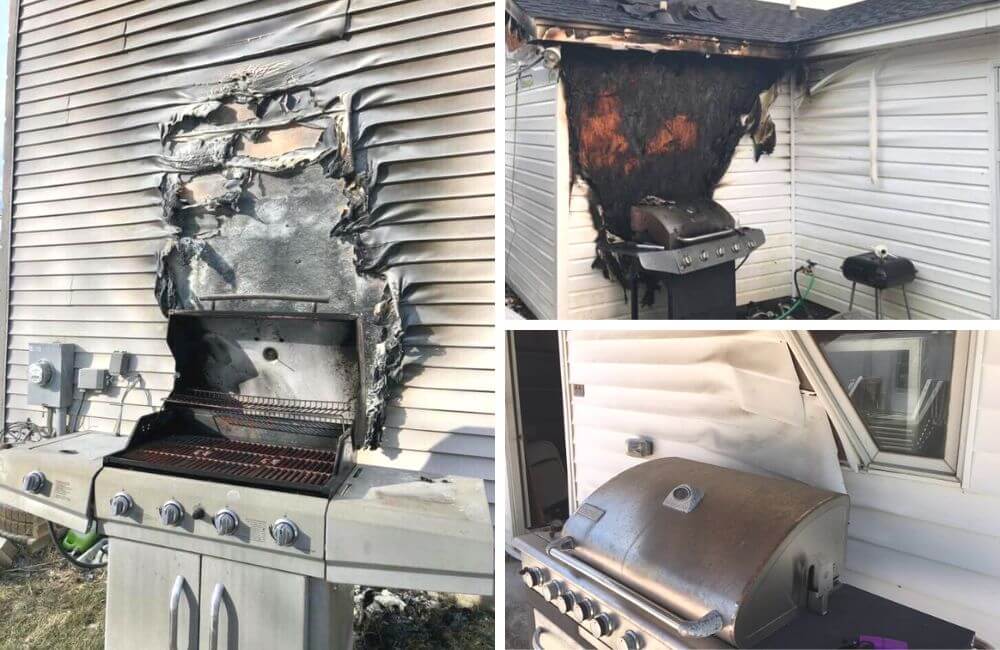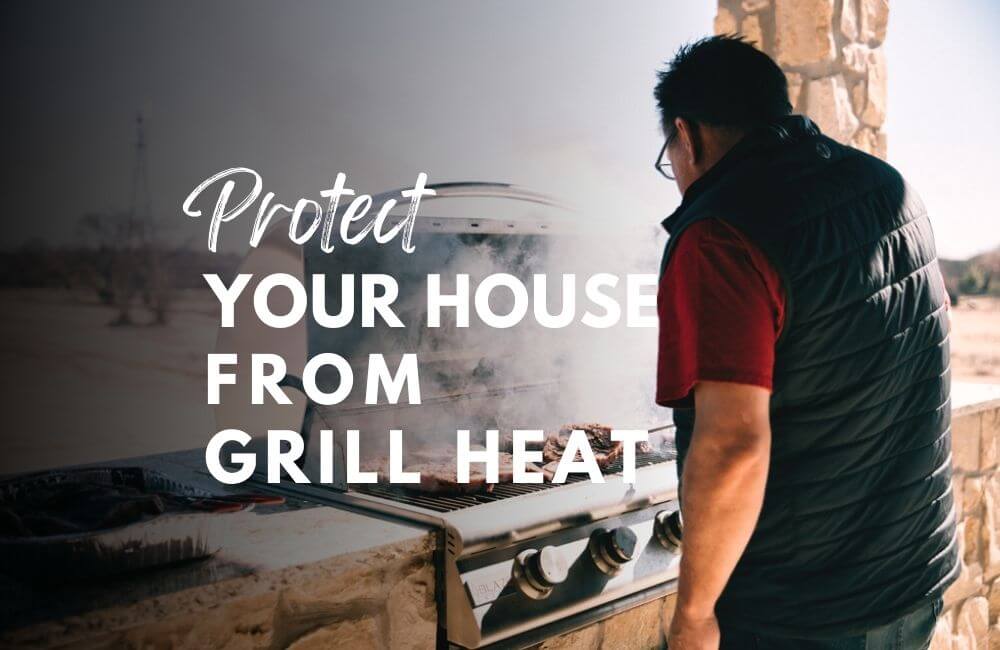Are you a fan of weekend barbecues and considering placing your grill against the wall of your house to save space or create a built-in look? Hold that thought! The short answer is no.
While this might seem convenient and attractive, it’s important to consider the potential hazards and take necessary precautions to ensure safety. The National Fire Protection Association (NFPA) reports that each year, thousands of home fires are caused by grills.
So, knowing how to grill safely is crucial before you fire up your grill. In this article, we’ll explore the minimum distance between the grill and the house, how to protect the siding from grill heat, and other grilling safety guidelines to keep in mind.
If you want to enjoy your grilled meals safely and without mishaps, keep reading to learn more!
Can You Place a Gas Grill Against Your House Wall?
If you’re an avid griller considering placing your gas grill against your house wall, you should first be aware of the safety hazards. The National Fire Protection Association (NFPA) advises against placing a grill near any structure, including your home. The NFPA’s Fire Code Section 10.11.7 states that no hibachi, gas-fired grill, charcoal grill, or other similar devices shall be used within 10 ft of any structure, including your house or any other building. This distance is crucial because it prevents the heat and flames from the grill from potentially igniting any nearby structures or materials.
It’s important to provide enough clearance between your grill and home to prevent fire hazards. For instance, the heat from an active grill next to the house can melt the siding and insulation underneath. In addition, a grill that hasn’t been turned off properly can easily catch fire, posing a significant risk to the home and its occupants.
How to Determine a Safe Distance from The Grill to The House?
One method is the “ten-foot rule”, which means keeping your grill at least ten feet away from any structure. This method aligns with the NFPA’s guidelines.
While grill manufacturers may have different recommendations, you should always follow the instructions accompanying your grill. These recommendations are designed to ensure the safe and optimal use of the grill.
Do not use the barbecue within 61 cm (24 inches) of combustible materials. This includes the top, bottom, back, and sides of the barbecue.
Weber Spirit II E-310 Manual
The appliance must be located away from combustible surfaces by at least 76cm / 30″ from each side and 76cm / 30″ from the rear.
Broil King Regal S 420 Manual
A minimum clearance of 914mm (36 inches) from combustible constructions to the sides of the grill and 914mm (36 inches) from the back of the grill to combustible constructions must be maintained.
Pit Boss Sportsman 1230 Manual
You can also use your judgment and consider the size of your grill, the heat output, and any wind or other weather conditions. By taking these factors into account and following the NFPA’s guidelines, you can safely enjoy your grilled meals without the risk of starting a fire.

Grilling Safety Tips
Before firing up the grill for your next barbecue, explore the following essential grilling safety tips to ensure a fun and safe experience for you and your loved ones.
1. Don’t Use a Grill in Enclosed Spaces to Avoid Co Poisoning
It’s important only to use your grill in well-ventilated areas, as using it in enclosed spaces can result in carbon monoxide (CO) poisoning. CO is an odorless and colorless gas that can be deadly if inhaled in high concentrations. Make sure to use your grill outdoors in a well-ventilated area.
2. Use a Heat Shield to Protect Your Siding from Grill Heat
As we mentioned earlier, placing your grill too close to your house can cause serious damage to your siding. To prevent this from happening, you can install a heat shield behind your grill. This protective barrier is typically made of non-combustible material and is designed to reflect heat away from your home’s siding, preventing it from melting or catching fire.
3. Trim Excess Fat from Meat to Prevent Flare-Ups
Trimming the extra fat from your meat is not only healthier, but it also helps prevent flare-ups. Flare-ups occur when fat drips onto the flames, causing them to flare up and potentially burn your food. By trimming the fat, you’ll reduce the chances of flare-ups and keep your food from getting burnt.
4. Clean Your Grill regularly
Cleaning your grill regularly is crucial for safety reasons. Grease and fat buildup can cause flare-ups, leading to a fire. To clean your grill, heat it up for 10-15 minutes to loosen any debris. Then use a grill brush to remove any leftover debris from the grates.
5. Check for Gas Leaks Before Use
Before using your gas grill, make sure to check for gas leaks. To do this, mix equal parts water and dish soap and apply the solution to the gas hose and connection. Turn on the gas, and if you see bubbles forming, you have a leak. If you detect a gas leak, turn off the gas and have the problem fixed before using your grill.
6. Consider Wind Direction and Speed On Windy Days
Grilling on windy days can be dangerous. The wind can cause the flames to flare up and potentially start a fire. When grilling on a windy day, make sure to place your grill in a sheltered area, away from any flammable materials. Additionally, keep an eye on the wind direction and adjust the position of your grill accordingly.
7. Never Leave a Lit Grill Unattended
It’s important never to leave a lit grill unattended. If a flare-up occurs or the wind picks up, you’ll want to be there to address the issue quickly. Always stay close to your grill when it’s in use.
8. Avoid Grilling Too Much Food at Once
Overloading your grill with food can lead to uneven cooking and increase the risk of flare-ups. To ensure even cooking and prevent flare-ups, only grill as much food as your grill can comfortably accommodate.
9. Always Shut Down the Grill Properly
After you’ve finished grilling, don’t forget to shut down the grill properly. Turn off the gas and wait for the grill to cool down before covering it. Failing to shut down your grill properly can lead to a fire.
10. Be Ready to Put Out a Fire
Finally, it’s important to be prepared in case a fire breaks out. Keep a fire extinguisher nearby and ensure everyone knows how to use it. If a fire does break out, turn off the gas and use the fire extinguisher to put out the flames.
Conclusion
Grilling can be a fun and delicious way to enjoy the outdoors, but prioritize safety. Always provide enough clearance between your grill and home, whether your siding is vinyl or brick.
By following the guidelines and tips discussed in this article, you can ensure that your grilling experience is not only enjoyable but also safe for you, your family, and your home.
Happy grilling!

I’m Jackson. I’ve been experimenting with different recipes and techniques to make the perfect plate of smoked or grilled meat for many years. I started this blog to share my experience with others who love grilling and smoking just as much as I do. Here you’ll find recipes, tips, tricks, and everything you need to know about making mouth-watering grilled or smoked dishes.

